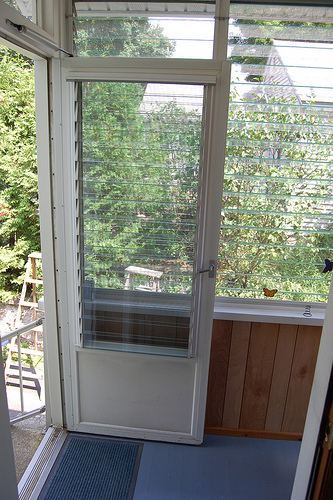 | ||
A jalousie window /ˈdʒæləsiː/ or louvre window (Australia, New Zealand, Pacific Islands, Southeast Asia, United Kingdom) is a window composed of parallel glass, acrylic, or wooden louvres set in a frame. The louvres are joined onto a track so that they may be tilted open and shut in unison to control airflow, usually by turning a crank.
Contents
Design
A patent for a basic louvered window was applied for in the US by a Joseph W. Walker, of Malden, Massachusetts, in 1900 and issued November 26, 1901, as patent no. 687705. A popular hand-cranked glass, aluminum, and screen window combination was designed by American engineer Van Ellis Huff and found widespread use in temperate climates before the advent of air-conditioning.
Use
Jalousie windows maximise natural ventilation by allowing airflow through the entire window area. Historically made only of wooden slats or glass panes, they are well suited to mild-winter climates. With mass production they became very common throughout homes in mid-20th-century Florida, Hawaii, southern California, the deep South, and Latin America. In cooler regions they were rapidly adopted to porches and sunrooms. They were also widely used in mobile homes during the 1950s and 1960s before most manufacturers began switching to sliding and sash windows in subsequent decades.
An additional advantage of jalousie windows is the ability to leave them at least partway open in most heavy rains, maintaining desirable ventilation whether a sun shower or prolonged tropical storm. On the downside, traditional style louvered windows offer poor overall resistance to water penetration and drafts. They also are difficult to positively secure, as their slats are easily and silently removed.
Modern jalousie windows, however, may be high-performance architectural windows, and have been featured in award-winning buildings.
Jalousies with extremely wide louvered panels (of six inches and more) are sometimes called awning windows.
Often confused in communication & conversation, the key difference between louvers & jalouises is that louvers are fixed position. Jalousies are installed within a movable adjustable mechanism which positions all jalouises into any parallel position with respect to each other.
